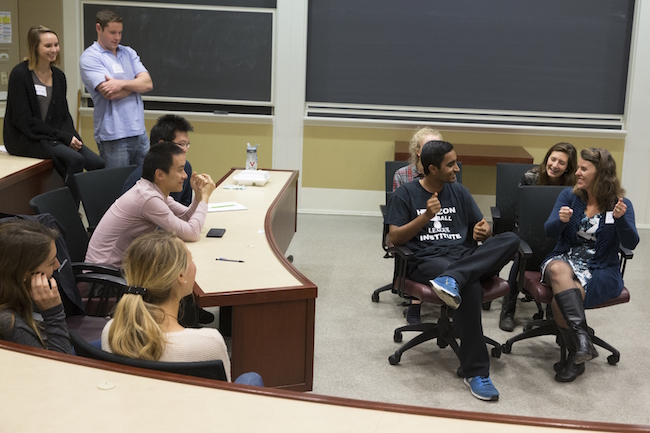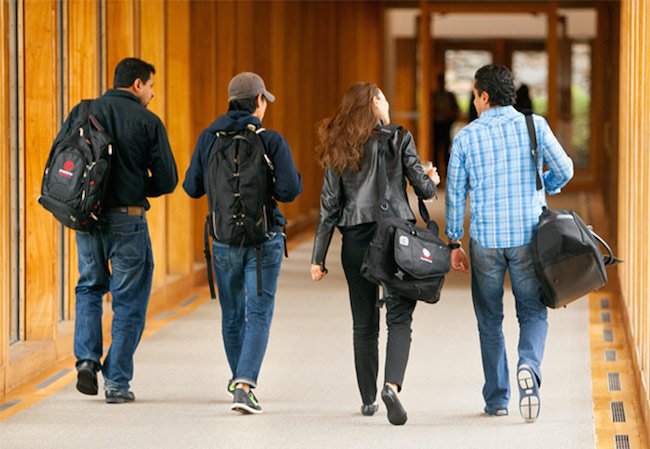
An improv class at the University of Virginia’s McIntire School of Commerce, which finished third in this year’s Poets&Quants ranking of the best undergraduate business programs. Professor Cady Garey is on the far right, seated, wearing a blue sweater. Photo by Dan Addison, University of Virginia Communications
BALANCED APPROACH CARRIES SOME UNLIKELY SCHOOLS TO THE TOP
This more balanced system of ranking undergraduate schools can sometimes lead to dramatically different results from a U.S. News list in which deans and senior faculty are more likely to tout undergraduate programs at only the big brand schools. Consider Santa Clara University’s Leavey School of Business. In the 2018 U.S. News ranking of undergraduate business schools, Santa Clara is in a 14-way tie for 64th place. In our ranking, Santa Clara places 16th. With a 46% acceptance rate, the school is very accessible. Some 93% of the graduates had jobs within three months of commencement and averaged more than $60,000 in average starting salary. Perhaps more importantly, recent alums rate their experience at the school highly. More than 58% of the Class of 2015 said they had global or signature experiences while at Santa Clara. Plus, more than 96% of the class said their first job after graduating was in their desired industry–and a impressively high 87% said that first job was at their targeted employer. While Santa Clara finished 23rd and 24th in the admissions and employment categories, respectively, the 12th place alumni experience rating propelled the school to the 16th spot.
Georgia Institute of Technology’s Scheller College of Business is another example. Ranked 31st in the most recent U.S. News ranking, the 105-year-old school has been known as a top 35 or so institute for years. In it’s first year in the P&Q ranking, however, the school nearly cracked the top ten, finishing 11th, sandwiched between the University of California-Berkeley’s Haas school of Business (tenth) and the McCombs School of Business at the University of Texas-Austin (12th). Akin to Santa Clara, the school’s spot was due to strong alumni satisfaction. In the alumni category, Scheller placed ninth. With an average incoming SAT score of 1400 and 86% of the class having gotten grades that put them in the top 10% of their high school classes, Scheller debuted higher than any other school this year.
The ranking is meant to identify balance among the three core components of a quality undergraduate experience, and for the second year, Washington University’s Olin School exemplified that goal. Olin didn’t outright win any of the three ranking categories but still finished solidly just behind Wharton. Similarly, the business schools at Notre Dame and Georgetown finished in the top five overall despite recording finishes outside the top ten in one of the three measured categories. Notre Dame placed 12th in the employment category, but rebounded by finishing fifth in the quality of its enrolled students the and fourth in alumni satisfaction. Meantime, Georgetown finished 11th in our alumni survey but reported admissions standards good enough for eighth place and employment rates that put them fourth.

Undergraduate students at Cornell University’s Dyson School, which had a 2.93% acceptance rate this fall. Courtesy photo
CORNELL DYSON’S ACCEPTANCE RATE? LESS THAN 3%
More important than a ranking, the Poets&Quants‘ report provides robust and previously unseen data that allows parents and students to make more informed college decisions. In coming days, we’ll publish articles featuring a wealth of proprietary data including in-depth features on schools with the highest scholarship rates, highest debt burdens, schools making the most innovative changes in their curricular and extra-curricular efforts, acceptance rates, average SATs, employment rates, as well as which schools enroll the most U.S. minorities and first-generation college students.
Among those findings are some revealing discoveries and trends. For example, Cornell University’s Dyson School now boasts an acceptance rate of just 2.9% (see Acceptance Rates At The Top 82 Undergraduate B-Schools). Wharton’s rate is 7.1% and the University of California-Berkeley’s Haas School of Business is 8.6%. All three schools are effectively harder to get into than Harvard Business School’s MBA program which accepts 11% of all applicants. Washington University’s Olin School now has an average SAT for its newly enrolled students of 1507 on the new 1600-point scale, which is up from 1480 last year. That puts the average in the 99th percentile of all SAT test takers meaning that only 1% of the students who took the test scored that highly on it. Wharton’s average SAT is now 1499, up from 1457 last year. Six other schools on the list have average scores of 1450 or higher.
Impressively, more than half the schools on the list reported that at least 90% of their 2017 graduates secured full-time job offers within three months of graduation. And the average salaries reported continue to reflect a frothy market for freshly minted business graduates. Wharton’s $80K is the first time an undergraduate school has reported an average salary of more than $80,000 for first jobs after graduation.
Indiana University’s Kelley School of Business recorded the second-highest salary at $77,499, an average boosted dramatically by an outlier. Kelley graduate and basketball star, Cody Zeller, who completed the employment report, was drafted by the NBA and received a four-year $56 million contract with the Charlotte Hornets. Otherwise, Kelley’s total compensation would come in at $66,026, behind 22 other schools. That’s still an exeptional return for an undergraduate program in Bloomington, Indiana.
In all, nine schools reported average salaries of $70,000 or higher, up from last year’s eight schools. Another 25 schools reported average salaries above $60,000, meaning more than 41% of the ranked schools have graduates making at least $60,000 in their first jobs after graduation–considerably higher than the estimated $49,785 average for overall undergrads, if they could land a job.
Poets&Quants’ 2017 Rankings Report
Wharton Tops 2017 Ranking Of the Best U.S. Undergraduate B-Schools
2017 Rankings Report Card: How Alumni Grade Their Business Schools
Undergraduate Business Programs That Help You Get The Job You Really Want
What Business Majors Made This Year In Their First Jobs
Acceptance Rates For The Top 82 Undergraduate Business Schools
How We Crunched The Numbers For Our 2017 Undergraduate Ranking












Questions about this article? Email us or leave a comment below.